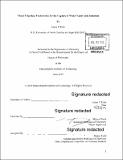Metal-triazolate frameworks for the capture of water vapor and ammonia
Author(s)
Rieth, Adam J.(Adam Joseph)
Download1126332672-MIT.pdf (24.53Mb)
Other Contributors
Massachusetts Institute of Technology. Department of Chemistry.
Advisor
Mircea Dincă.
Terms of use
Metadata
Show full item recordAbstract
Metal-organic frameworks (MOFs) are emerging materials for applications in gas sorption and separations, however, they are widely believed to be unstable towards coordinating vapors such as water and ammonia due to often-rapid hydrolysis or substitution at the metal-ligand bond. Here, we describe a series of micro- and mesoporous MOFs constructed from robust metal-triazolate bonds, which, together with a high density of open metal sites, enable these frameworks to exhibit record water uptake as well as record static and dynamic ammonia capacities. Optimization of the pore diameter has led to materials which adsorb large volumes of water with complete reversibility, portending application in the production of potable water in desert regions as well as for heat transfer and storage. Further studies illuminate the mechanism of initial water clustering at and around the metal-centered open coordination sites. For ammonia, systematic variation of the pore size and metal ion lead to materials with a greater affinity and more than twice the capacity for ammonia than activated carbon, the industry standard for protection and mitigation from this toxic and corrosive gas. Structure-function relationships and kinetic analyses of NH₃ and H₂0 uptake in isostructural micro- and mesoporous materials made from Mn, Co, Ni, and Cu reveal stability trends that are in line with the water self-substitution rates in simple metal-aquo complexes. Altogether, these results provide clear, intuitive descriptors that govern the static and dynamic uptake, kinetics, and stability of MOF sorbents for strongly interacting gases.
Description
Thesis: Ph. D., Massachusetts Institute of Technology, Department of Chemistry, 2019 Cataloged from PDF version of thesis. Includes bibliographical references (pages 93-108).
Date issued
2019Department
Massachusetts Institute of Technology. Department of ChemistryPublisher
Massachusetts Institute of Technology
Keywords
Chemistry.